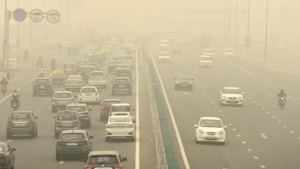New Delhi – Delhi AQI continued to stay in the “poor” category for the second consecutive day on Wednesday, recording an average of 233 at 4pm, worsening from Tuesday’s 211. The Central Pollution Control Board (CPCB) data revealed that the national capital’s air quality is gradually deteriorating as meteorological conditions become unfavourable with each passing day.
Experts warn that the Delhi AQI is expected to worsen further, entering the “very poor” category by Diwali, as a combination of low wind speeds, mist during early hours, and dense traffic contribute to pollution buildup. Adding firecracker emissions and stubble burning to the mix will intensify the smog levels across the region.
Forecast Suggests Worsening Air Conditions

The Air Quality Early Warning System (EWS) for Delhi has projected that the Delhi AQI will remain in the “poor” range between October 16 and 18, but will likely shift to the “very poor” category by October 20 and 21. Experts note that the deterioration in air quality is in line with the onset of winter, when temperature inversion and low wind movement trap pollutants close to the ground.
On Wednesday, out of the city’s 39 monitoring stations, eight reported Delhi AQI readings in the “very poor” range. The most polluted areas were Anand Vihar with an AQI of 349, Wazirpur at 324, and Patparganj at 317. The persistent smog and haziness in the city’s atmosphere indicate the compounding effect of urban emissions and seasonal changes.
Major Sources of Pollution Identified
The Decision Support System (DSS), which tracks the contribution of various sources to Delhi AQI levels, revealed that transport emissions accounted for 16.7% of the city’s PM2.5 concentration on Wednesday. Pollution from adjoining regions such as Ghaziabad (8%) and Gautam Budh Nagar (7.8%) also added to the deteriorating air quality.
While the contribution of stubble burning was only 0.2% on Wednesday, marginally down from 0.5% on Tuesday, forecasts show that it may rise to 4% by Friday and 4.8% by Saturday. Experts emphasized that as crop residue burning increases across Punjab and Haryana, the Delhi AQI will further decline, especially with stagnant weather conditions.
Also Read: South Asian University Delhi: Shocking Assault Case Under Investigation
Meteorological Conditions Turning Adverse
According to meteorological forecasts, Delhi is likely to experience shallow fog during the early morning hours over the coming days. Mahesh Palawat, vice president of a leading meteorological agency, stated that haziness will intensify around Diwali as wind speeds drop and humidity rises. “Daytime temperatures will slightly increase, but low wind speeds and misty mornings will make atmospheric dispersion of pollutants difficult,” he explained.
The gradual build-up of pollutants, combined with festive emissions, will push Delhi AQI to alarming levels if preventive measures are not enforced rigorously. Officials have urged residents to avoid unnecessary vehicular travel and use public transport wherever possible to help curb pollution growth.
Authorities Activate Stage-1 Measures Under GRAP
With the Delhi AQI crossing 200, the Commission for Air Quality Management (CAQM) in the National Capital Region invoked Stage-1 measures of the Graded Response Action Plan (GRAP) across the entire NCR. These emergency measures are aimed at curbing dust, vehicular, and industrial emissions to prevent further degradation.
Under GRAP Stage-1, agencies have been directed to ensure periodic mechanized sweeping and water sprinkling on roads to control dust levels. Enforcement teams are conducting strict checks on vehicles for pollution under control (PUC) compliance and penalizing visibly polluting vehicles. The Delhi government has also ordered regular lifting of solid waste and immediate halting of construction and demolition (C&D) activities at sites larger than 500 sqm that are not registered on the official dust control portal.
First ‘Poor Air Day’ Since Pre-Monsoon Period
This week marks the first “poor air day” since the pre-monsoon season, when Delhi AQI touched 245 on June 11. Experts highlight that this seasonal transition phase always brings an increase in pollution levels as post-monsoon winds weaken and moisture levels rise. The return of poor air quality conditions this early in the festive season raises concern about public health impacts, particularly respiratory issues among sensitive groups.
Health experts continue to advise vulnerable populations, including children and the elderly, to limit outdoor exposure during morning and evening hours when pollution levels peak. Using N95 masks, air purifiers, and keeping windows closed during high AQI hours can help mitigate exposure to particulate matter.
Outlook for the Coming Days
As Delhi prepares for the festive season, authorities and environmental experts warn that the Delhi AQI may slip into “very poor” or even “severe” levels if stringent controls are not maintained. The rising pollution from vehicular emissions, coupled with seasonal stubble burning and cracker use, could create hazardous conditions across the capital and its adjoining regions.
Preventive actions under GRAP and individual efforts such as reduced private vehicle use, adherence to pollution norms, and avoiding firecrackers are essential in controlling the worsening Delhi AQI. With Diwali approaching, the coming week will be crucial in determining whether the city can avoid the annual smog crisis.

